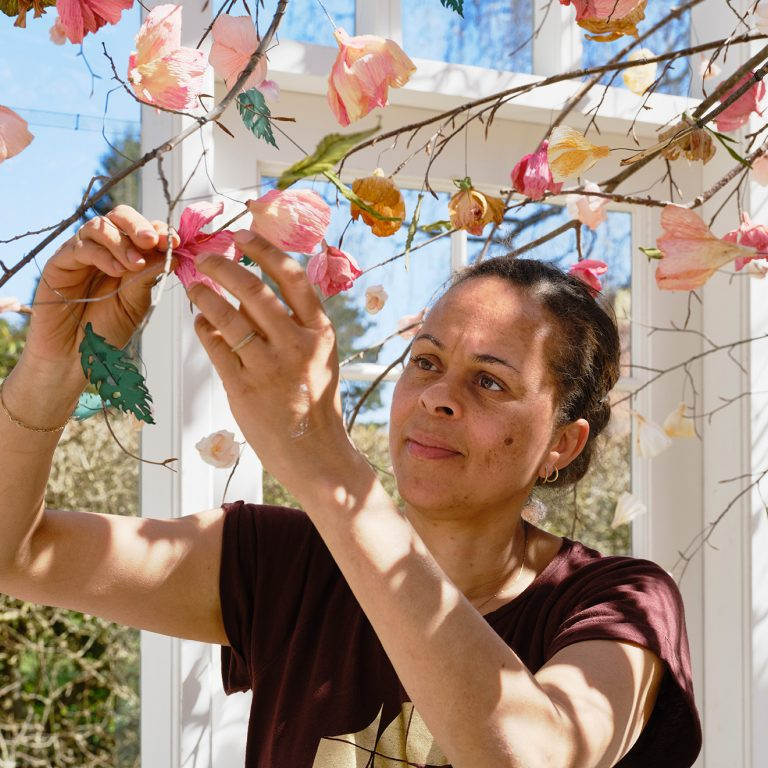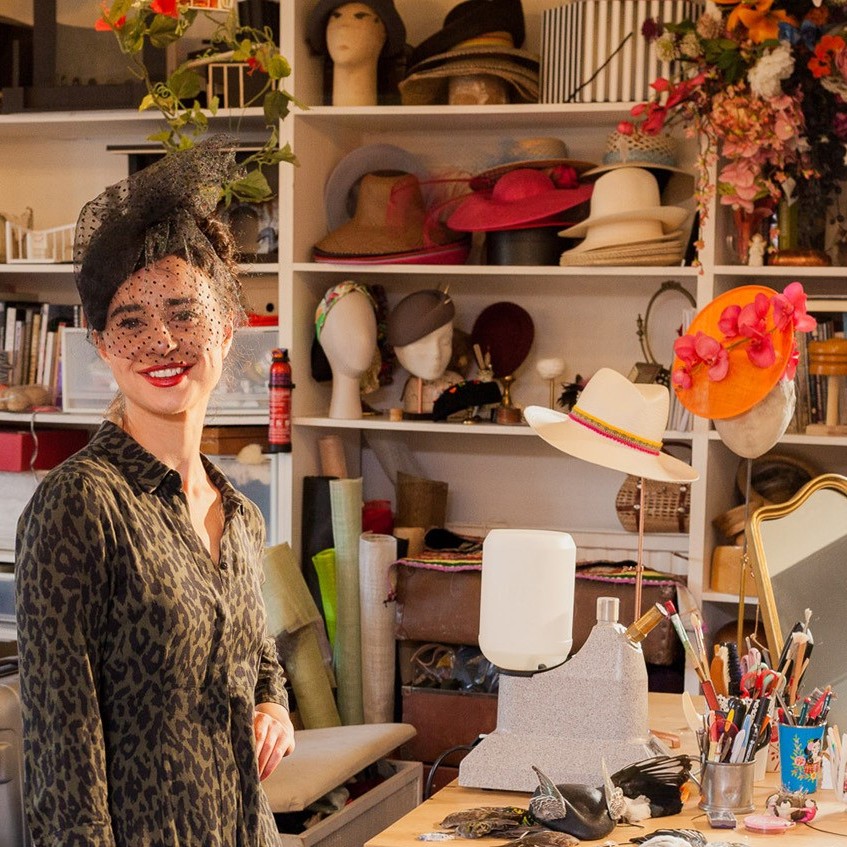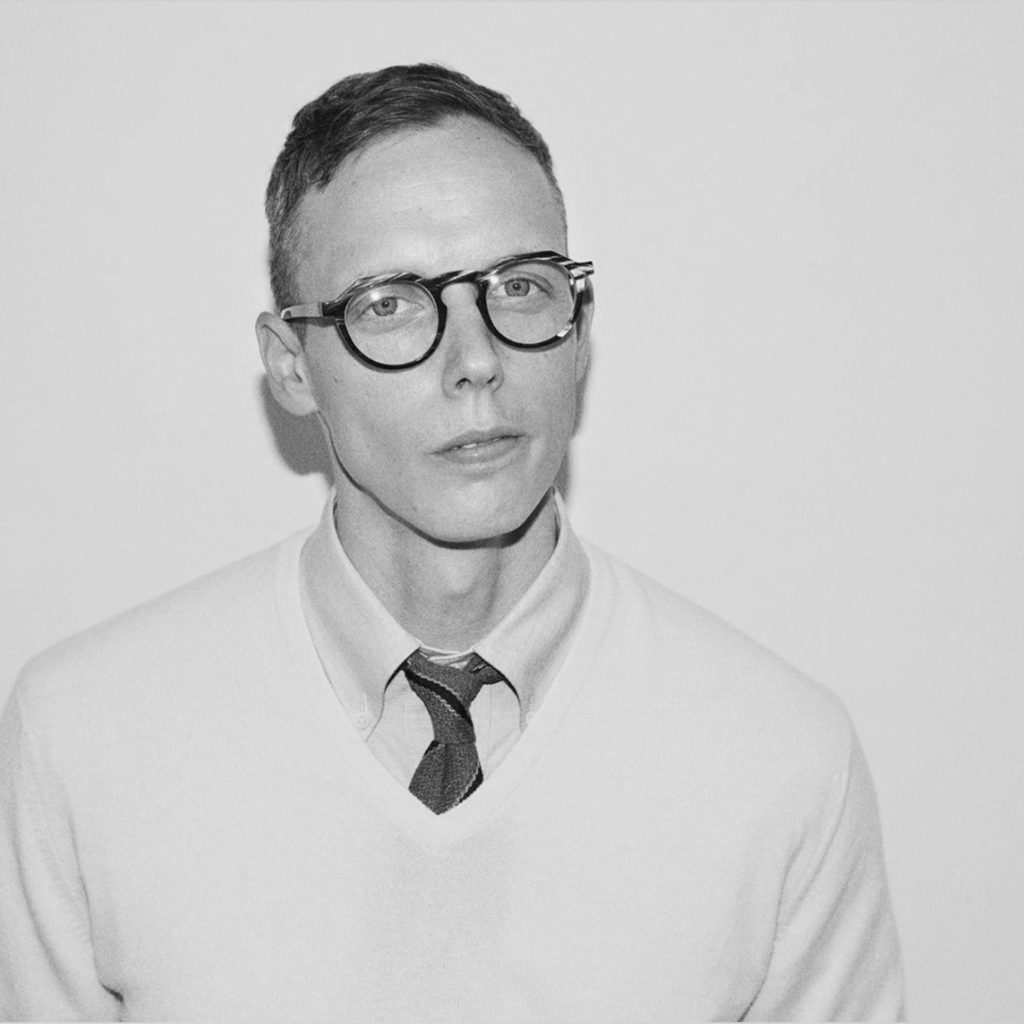Nigel Cheney Textile Artist and Designer
Your work is often full of storytelling – comment.
I am driven by narrative. I tend to anthropomorphise to an unhealthy extent and from an early age saw inanimate objects as protagonists in some drama of my invention. I did very badly in English at school and lost all confidence in my writing. I found that drawing conveyed stories more eloquently that prose. I adore the depth to poetry, and how it can be so open to interpretation, but just don’t have the vocabulary to do it myself. I suppose the most inspirational quote is one by Gustave Flaubert: “There is no truth. There is only perception.”
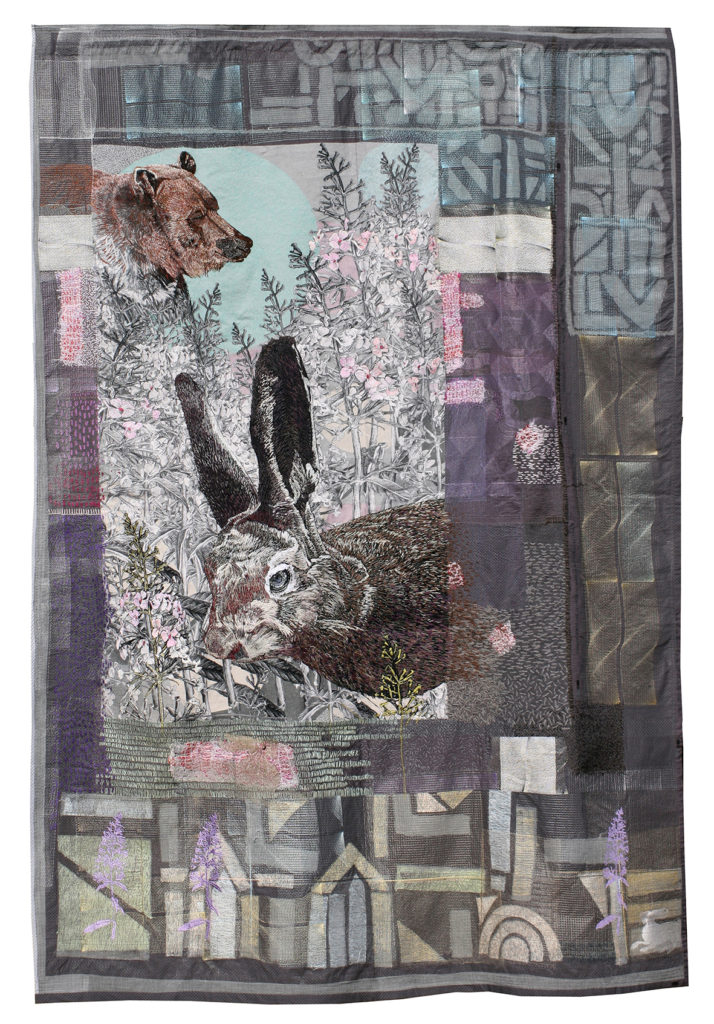
‘Telling Stories’ 140 x 200cm, 2011
I enjoy describing the inside story of the development of a piece but I often reinterpret its intention differently with each retelling. Time offers its own perspective. I have had a recent conversation with a friend who was discussing one of her favourite songs and loving it despite having no idea what the songwriter meant with the obtuse lyrics.

Detail, ‘Telling Stories’ 140 x 200cm, 2011
I googled several articles where the performer had talked about it, with inherent contradictions as she reflected over a period of time. It is that ambiguity I aspire towards.
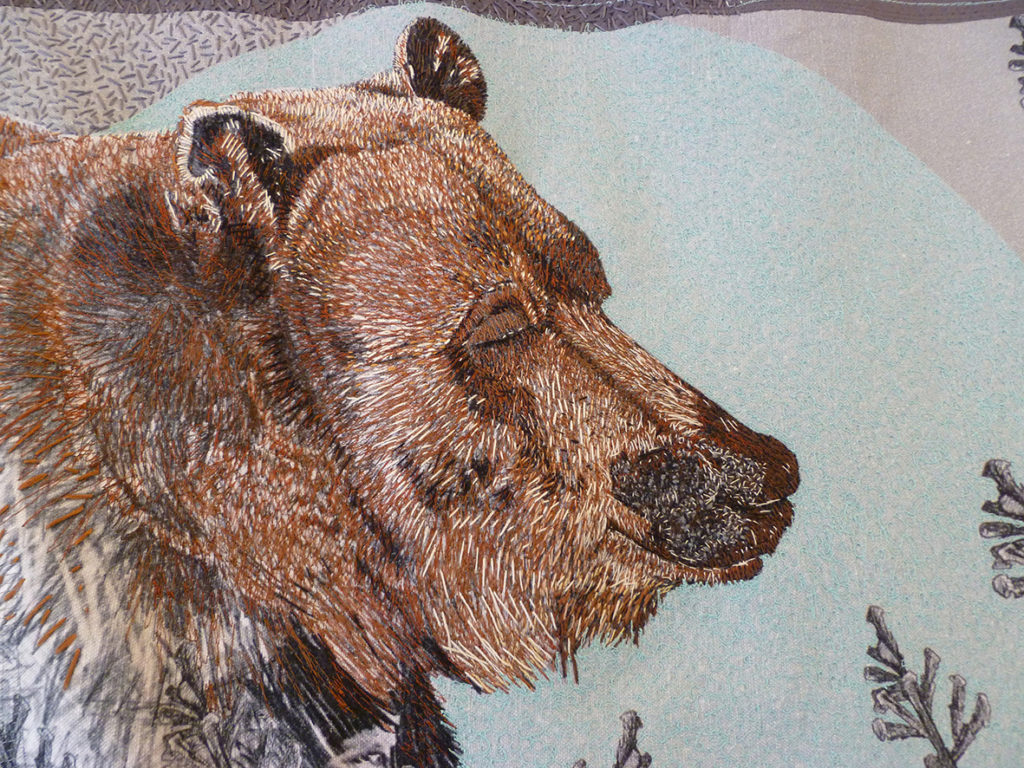
Detail, ‘Telling Stories’ 140 x 200cm, 2011
How many techniques are used in ‘’ Coat for Lethbridge Sisters’?
How did this piece come about?

‘Coat for Lethbridge Sisters’ 2015
“Coat for the Lethbridge Sisters”, is a piece of wearable art produced between July and October 2015. It represents 80 hours of hand and free machine embroidery over digital printing before being quilted to produce a one-off silk coat. We were approached by Dr. Lynne Hulse and Caroline McNamara regarding their research project and involving the students in a competition. This was all relating to Dr. Hulse research on the two sisters for her book. ‘Passion and Legacy: The legacy of the Irish Arts and Crafts Movement with particular reference to the work of the Lethbridge Sisters (Julia Baroness Carew (1863-1922) and Lady Jane Cory (1865-1947)): a source of inspiration for design in the 21st century. ’The lecture she gave at Girton College Cambridge, in the room full of Lady Julia’s embroideries on the lives of the two sisters was fascinating. It was the driving factor in making the coat. The imagery for the coat was taken from archive images of their work and portraits. These were combined with an original drawing of her King Charle’s Spaniel and manipulated in photoshop.
What is the percentage of hand stitching on the piece?
The only hand stitching is the portrait of the dog ‘Poppy’ on the centre back
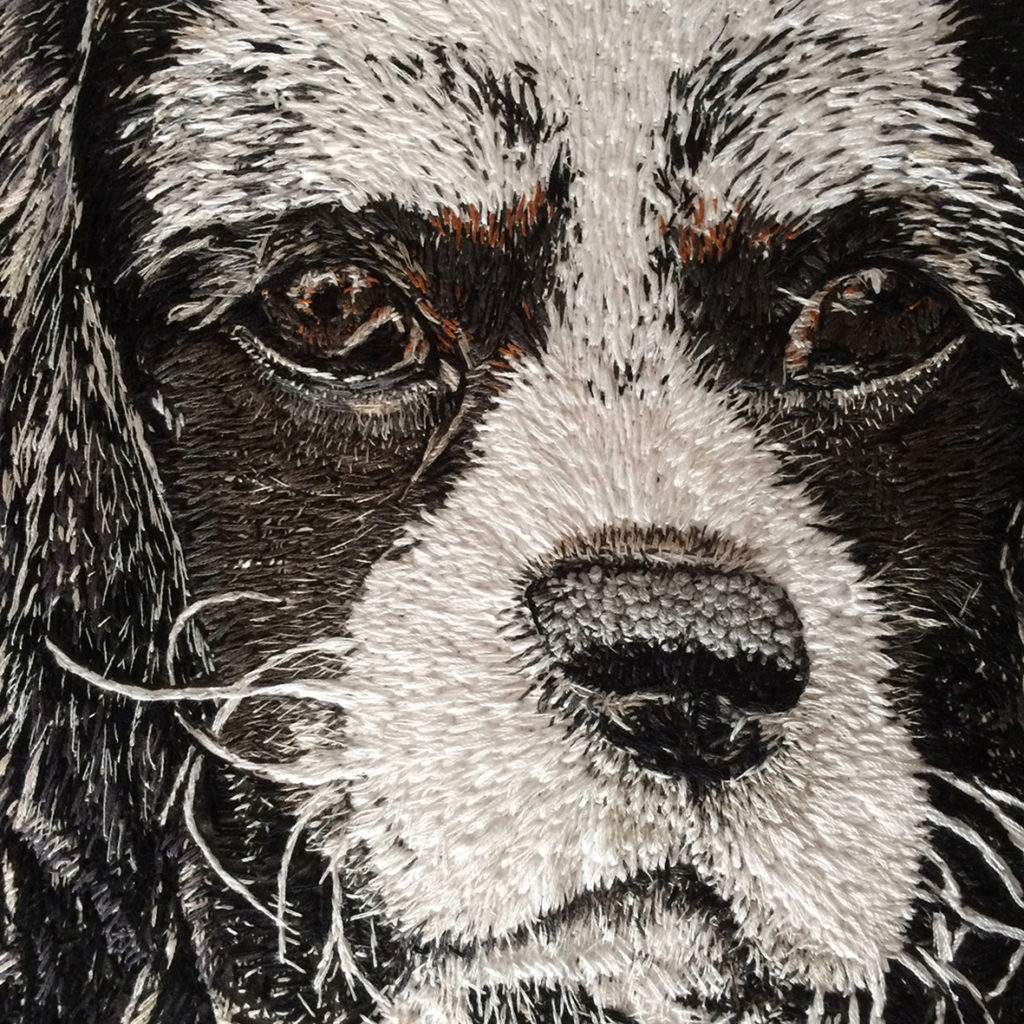
Detail of Poppy the dog on the centre back of ‘Coat for Lethbridge Sisters’ 2015
and the French knots on the sheep.

Detail of French knot sheep, ‘Coat for Lethbridge Sisters’ 2015
The rest is machine quilting emphasising their embroidery. In percentage terms it probably covers about 10% of the cloth in total, took over 90% of the time.
How do you work to deadlines? What changes do they bring?
I think I respond well to deadlines. (every student I have ever taught has written this and the eyes roll to the back of my head). Having taught both Design and Fine Art students I use the following analogy. Design students need training like sprinters. They like short term goals, lots of feedback monitoring their progress and a rhythm to the years calendar with seasons and deadlines. Fine Art students need training like endurance runners who are perpetually in training but balk at the idea of a finishing line. They are driven by their own improvement more than how well others perform. I suppose I am a mix of both.
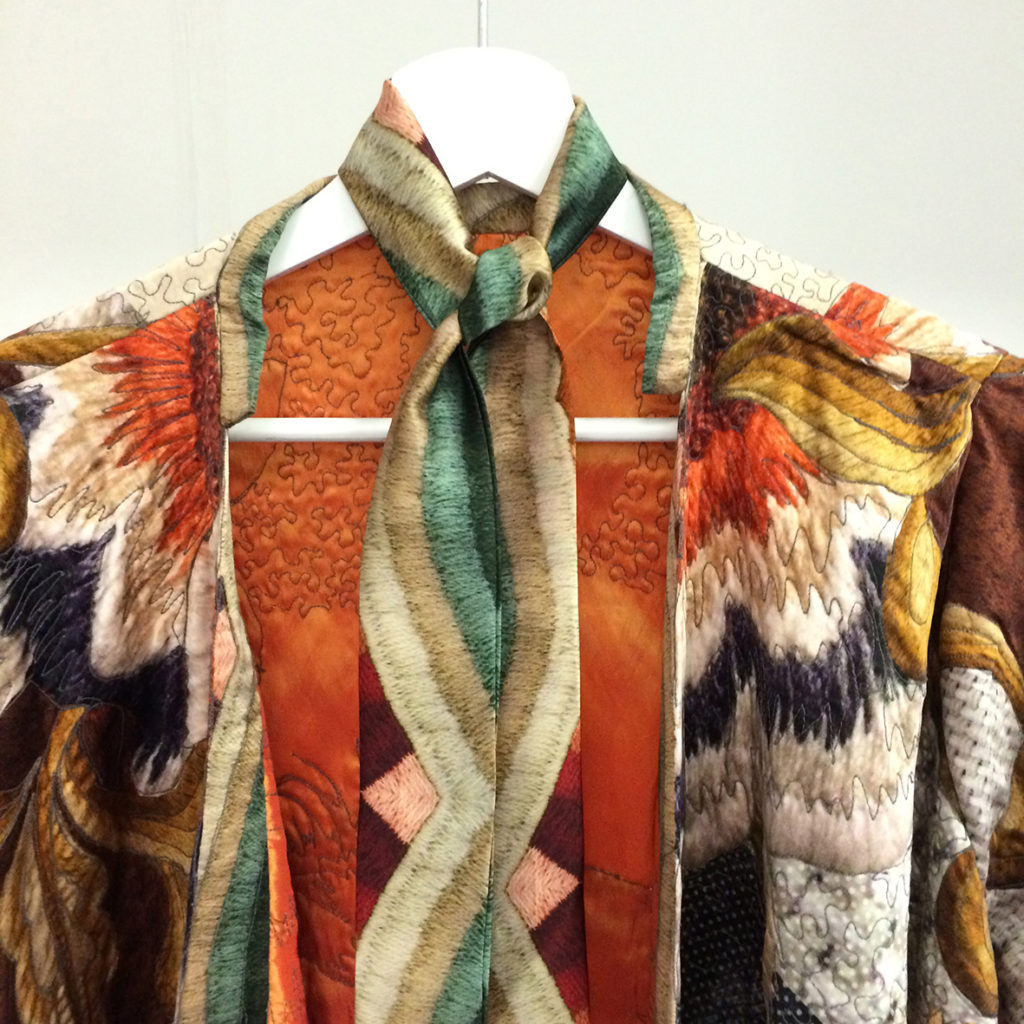
‘Coat for the Lethbridge Sisters’, Detail, 2015
The ‘Coat for the Lethbridge Sisters is a case in point. The deadline was very tight and I had full time teaching simultaneously. I feel that I didn’t do this project ‘properly’. I just didn’t have time. Certainly not a methodology I would advocate to students. Particularly the garment development was more ‘make the cloth and work out how it turned into a thing later’. There was no toile with pinned on motifs, no careful scale tests of the design.
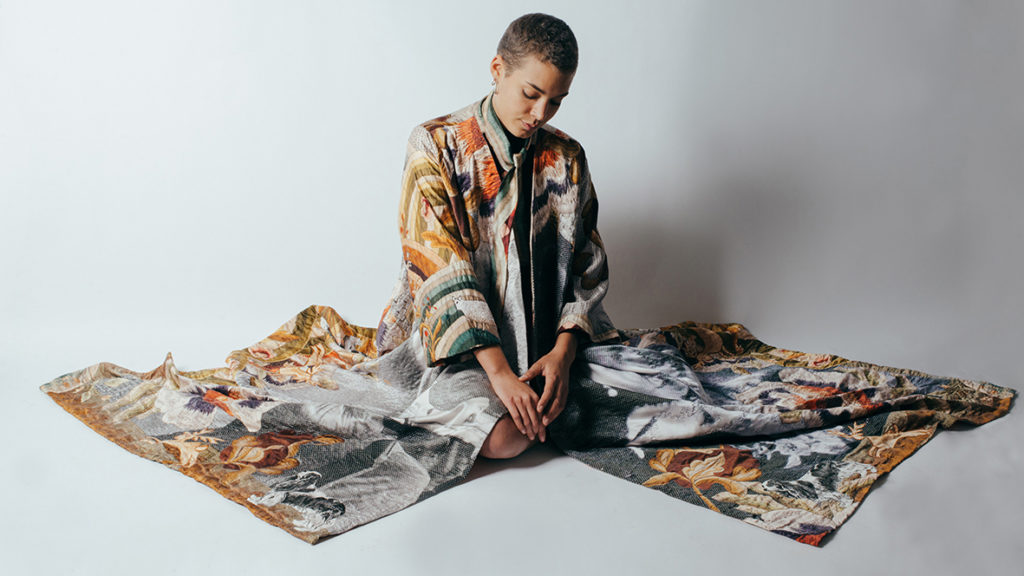
‘Coat for the Lethbridge Sisters’
These are things I would insist students did. I just had a sense that this was what I needed to do and after all it would be a bit of cloth and I could chop it up if worse came to worst. I found myself with a tape measure and my sister’s anorak estimating where the motifs would need to be placed on the final garment. Working on a small notebook computer I ‘photoshopped’ merrily away, with obscene confidence that it would all come out right. I created the large digital files. Anticipating that if the motifs were composed similarly to a medieval cope then they would just look right when worn. It was kind of a virtual ‘decoupage’ sticking images of stitched motifs from the Girton embroideries at different scales within the composition. The honeysuckle would go here and the leaf there. The sleeves had to be asymmetric and the front panels dominated by enormous portraits of the sisters. The dog sat firmly on their back, nestled under the miniature of Lady Jane. All on a screen 10 inches big….. A ridiculous way to work but all I had to hand at the time!
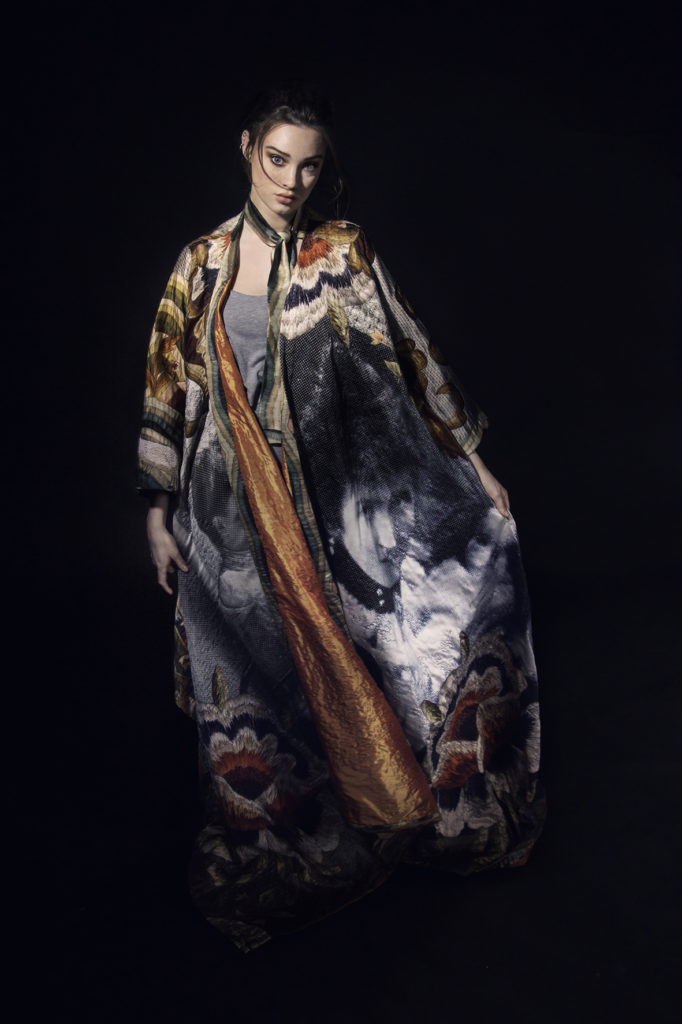
‘Coat for the Lethbridge Sisters’
Comment on how new techniques such as digital printing has changed your art practice.
I worked with screen printing and oil based inks at school for A’ Level. I love the results but have allergies with the cleaning chemicals. One reason I loathe oil painting. In college I did screen printing on textiles. The chemistry of mixing dyes and the skill required to colour match successfully was beyond my limited patience. I respond to the immediacy of colour. The challenge of getting my drawing onto cloth without having to replicate every stitch (which would still be my preferred option) was driven by necessity of speed. I first used digital printing 20 years ago. To realise it I had to visit a mate in London who worked on photoshop for me and sent to a company there. The expense was astronomical, the quality was dreadful, but the potential was alluring. It is quite amazing how far the industry has come on now.

The Fall of St. Sebastian from the a ‘Appendices’ Exhibition, 2000
For many years I relied heavily on digital stitch as I was using my research time to explore what our college facilities could produce.
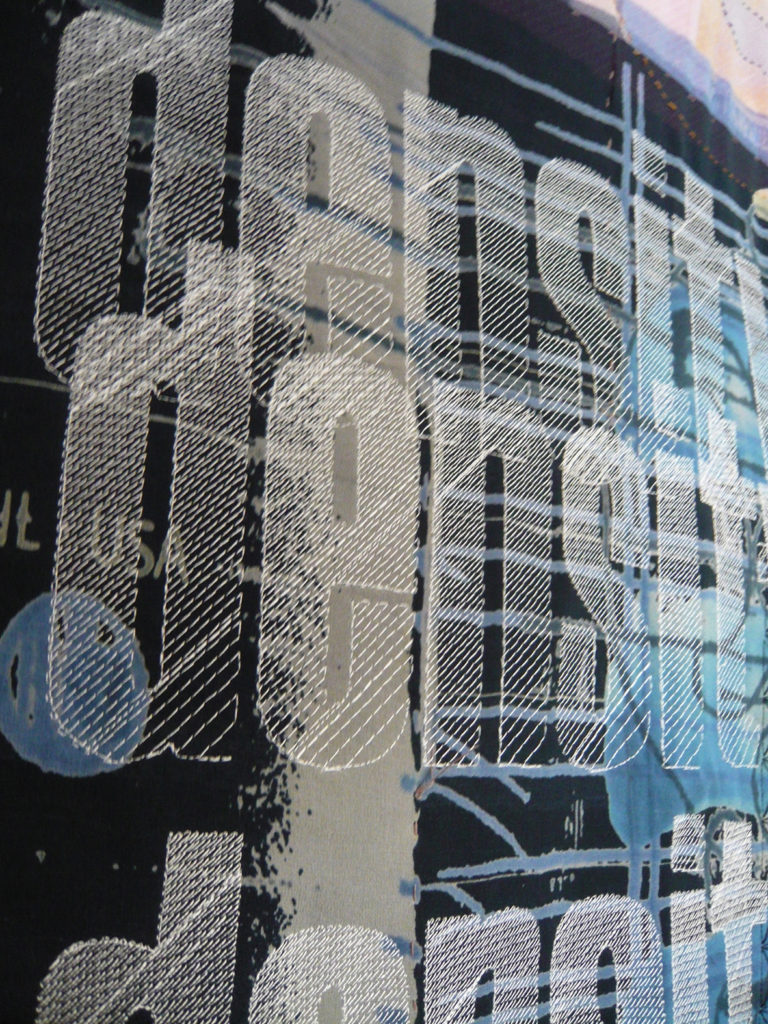
Detail, digital stitch fills
You are a member of 62 Group. How did this happen?
I remember the importance of their exhibitions from as long as I knew about textile art at school. It was one of those dreams to be a member that you have in the quiet of night and talk yourself out of in the daylight. I grew up watching Jan Beaney do machine embroidery on Pebble Mill at One on the TV! I applied not thinking I would make it past the first selection process.
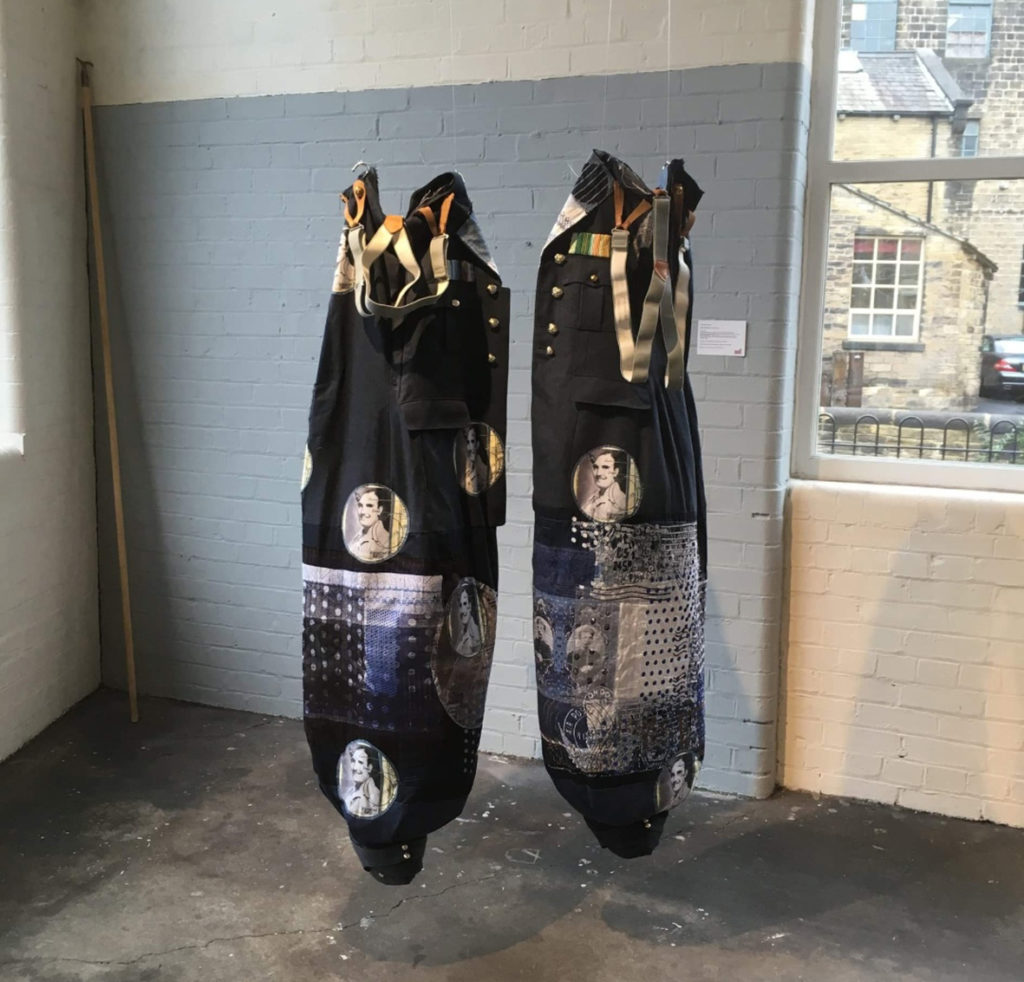
‘Whortleberry I and II,from the 62 Group, ‘Construction’ Exhibition, Sunny Bank Mill, Leeds,
What have you given them?
Very little, I suspect. I currently manage their social media accounts. So at the least I am useful. I do think I have a different emphasis than many of the members. That diversity is part of its attraction. The way things have worked so far I haven’t shown work that is more drawing based. It hasn’t suited the themes until the latest. The piece for the postponed ‘conversations’ exhibition is basically a drawing that is mirrored so that a moment from the past faces a reflection of that memory. ‘Both sides now’ is wrapped up ready to post. I’m not sure I will ever unwrap it.
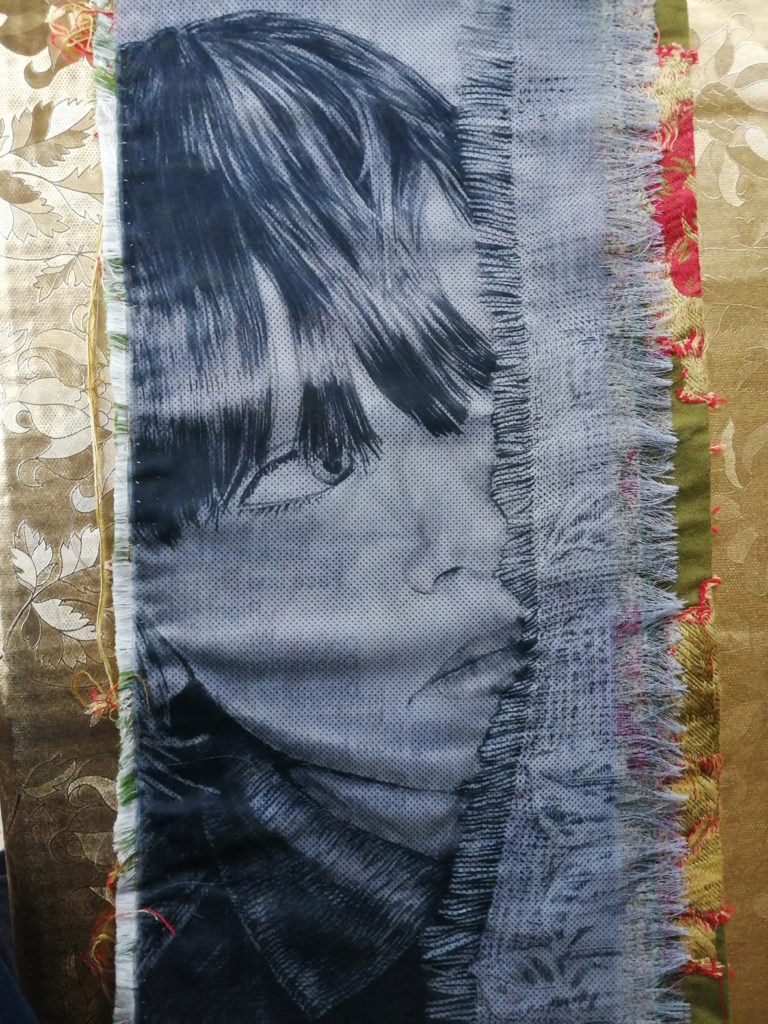
Detail, ‘Both Sides Now’, Digital print over machine embroidered ground on vintage jacquard fabric, 30 x 120cm, 2020
Comment on the importance of shows and exhibitions to your career?
I have been very fortunate to have been part of some interesting group shows that have led onto other solo shows. For me the Knitting and Stitching shows have been a great supportive platform.
 Family Portrait, 200cm tall, from ‘Decorated’, NCCD, Sleaford, 2017
Family Portrait, 200cm tall, from ‘Decorated’, NCCD, Sleaford, 2017
The two solo shows that have been most pivotal were ‘decorated’ in 2017 in NCCD Sleaford based on my response to WW1 Aspects of this went on to tour London, Dublin, Tipperary and Harrogate and Greenham Common. Their inclusion in Rijswijk Textile biennale last year was very poignant.

Work on display at the Rijswijk Textile Biennale
‘The Birth Certificate’, Differtential shrinkage panels, linen and wool with hand stitching 50 x 50cm, 2019, Island Arts Gallery Lisburn, exhibition, The Shepherds Daughter’.
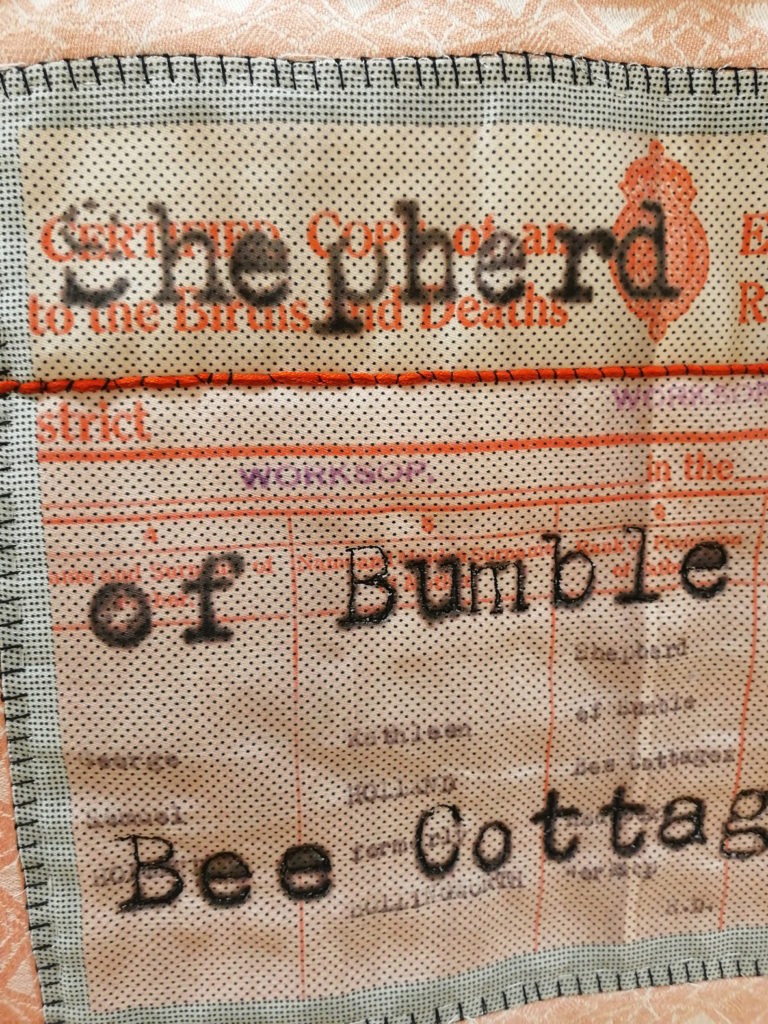
‘The Shepherd’s Daughter’ 2019 Island Arts, Lisburn, Northern Ireland.
The Shepherds Daughter’.reflected on my mother’s life and the experience of a farm girl who went to work in the local Garment Industry in the 1950’s before becoming a stay at home mum.
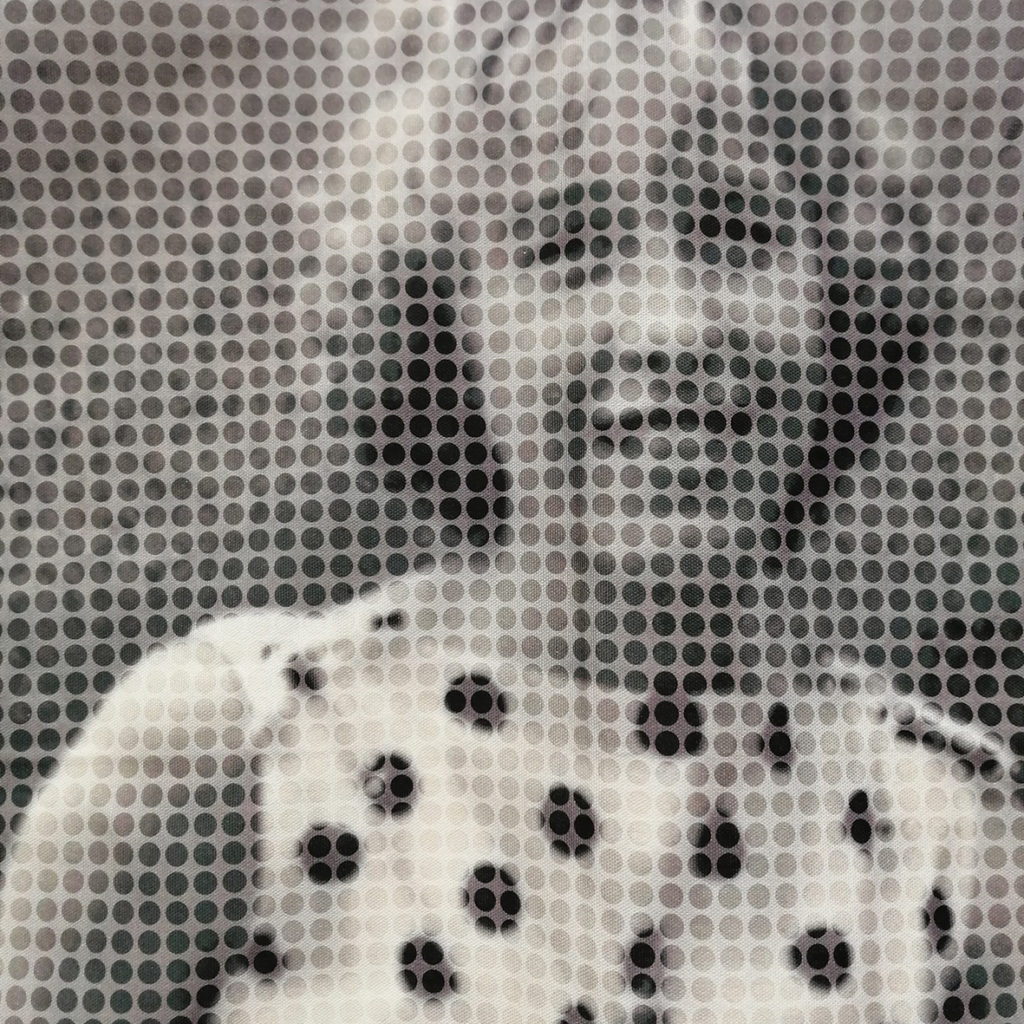
‘His Two Loves’ Island Arts Gallery Lisburn, exhibition, The Shepherds Daughter’, Digital print on cotton twill, 140 x 200cm, 2019.
It used a lot of family photos and was a nice foil to the uniform based work I had been involved with for 5 years.
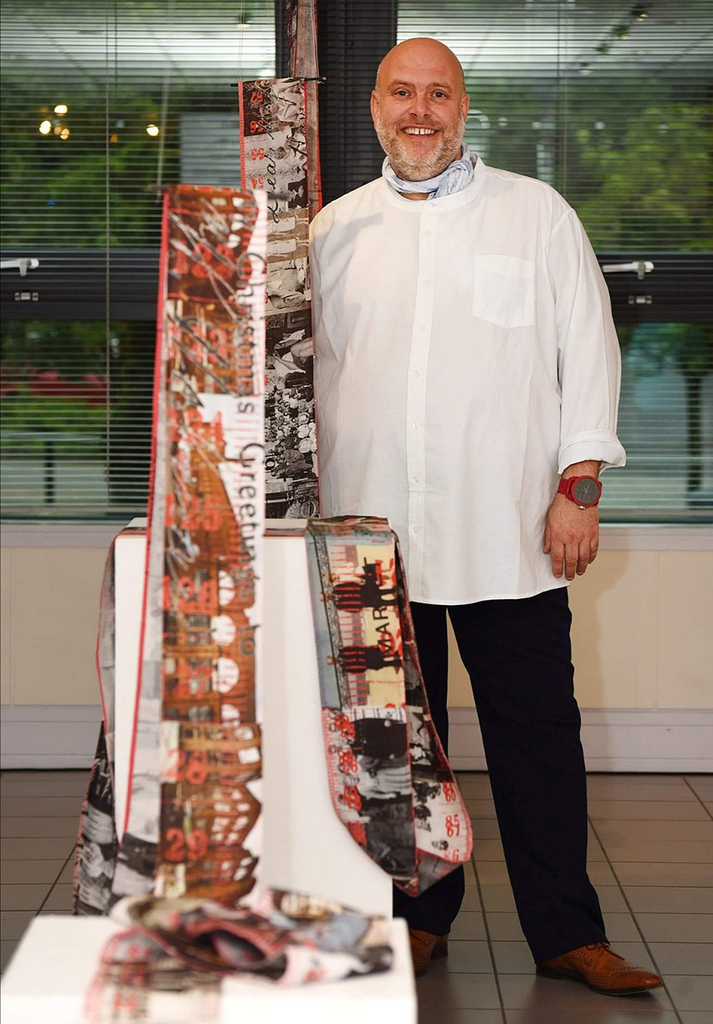
Nigel Cheney with installation at Lisburn, The Shephard’s Daughter
Many of your works are large scale – discuss scale and textile design.
I consciously try and make smaller things. At the end of every exhibition my friends can’t contain their merriment as I vow to never work bigger than a postage stamp in the future. I used to able to paint miniatures with a 00000 paint brush.

‘Starling’ painted in gouache on paper 20 x 10cm. 1984
Now I struggle to draw smaller than A1.
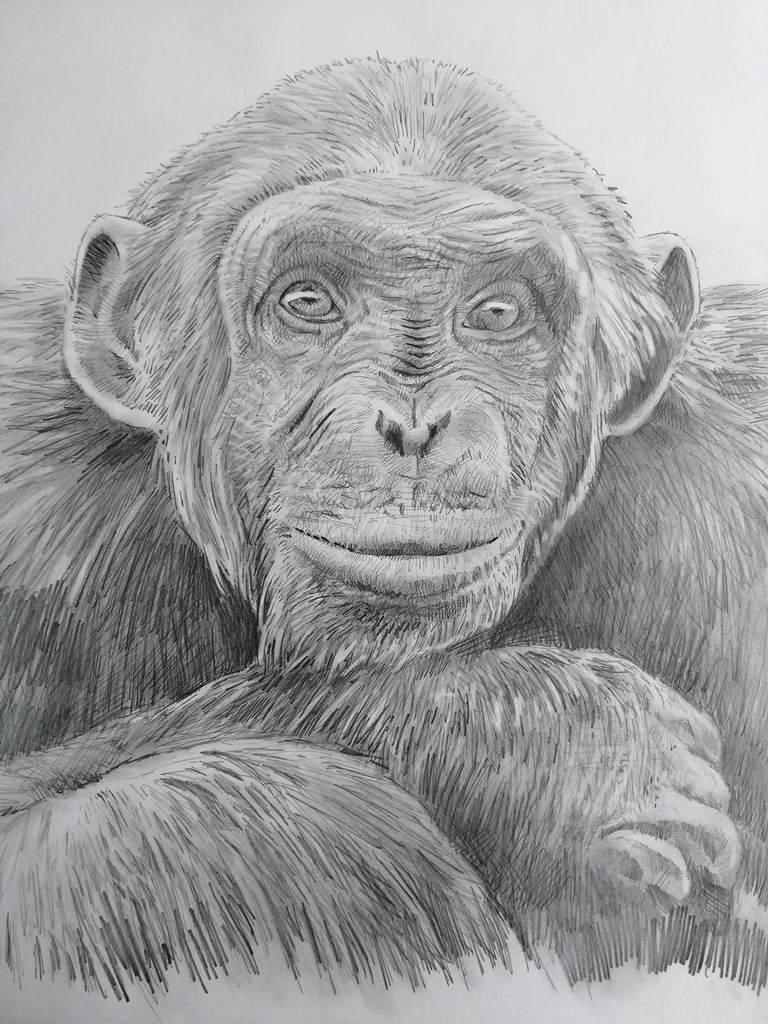
A1, drawing “Naree the Chimpanzee – from Monkey World, Dorset, 2020
Iam limited by my ‘studio’. Unlike many of my peers I don’t have the beautiful purpose built, or adapted studio. I moved back home to England to be a carer for my family. The 4 of us reside in a small 3 bedroom bungalow in a small market town in the East Midlands. They are incredibly tolerant as I spread over every surface, however the deal is that it is always tidied away. Working in these short bursts where you can’t, just leave things pending, is a change from living alone in your own home. Practicalities such as that the sewing machine must be got out and put away each time, has really changed the way I work. I save up machine sewing till there are several things to do.
What is your current inspiration and what are you working on while in isolation?
I’ve been working for months on a large scale quilt with a massive amount of hand stitch looking at a pair of Gibbons. It’s for a competition so I can’t share images of the whole thing yet but my mum thinks it is the best thing I’ve ever done! Who knows if anyone will ever actually see it in the thread?

Sneak peek of ‘Couple Goals’, in progress, hand stitch over digital print, 200 x 140cm, 2020
Big pieces can get scary and I find there are stages when I need to put them aside and work on a different series or finish a different project to distract myself. I have been piecing all the offcuts, I’ve saved and starting to work on throws, that allow me to play with colour through simple running stitch with a fake ‘kantha’ approach.
The inspiration is the physicality of stitch and the need to be creative with the limited materials and threads I have in stock.
It has been an opportunity to finish several previously abandoned projects such as the ‘money for nothing’ suitcases that I started 3 years ago.

‘Money for Nothing Suitcase’, 75 x 40cm, 2020
I’m part of a local guild and we do ‘travelling books’.
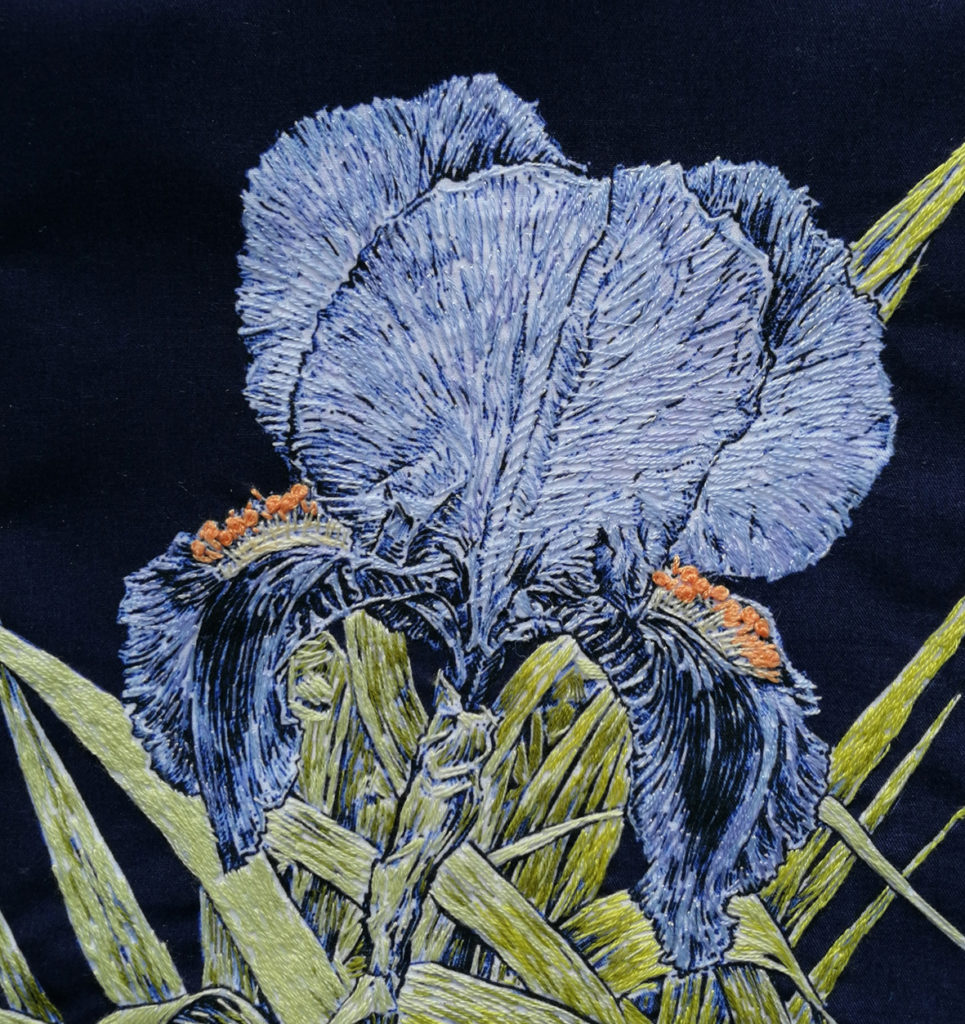
‘Iris’, From Travelling Books, 40 x20 cm,2020
Fifteen of us decide on individual themes and each start a 20cm square notebook. Every month we make a piece based on this research and then swap books. So eventually we have all contributed to each theme. It offers a really, different challenge to what I would normally make.
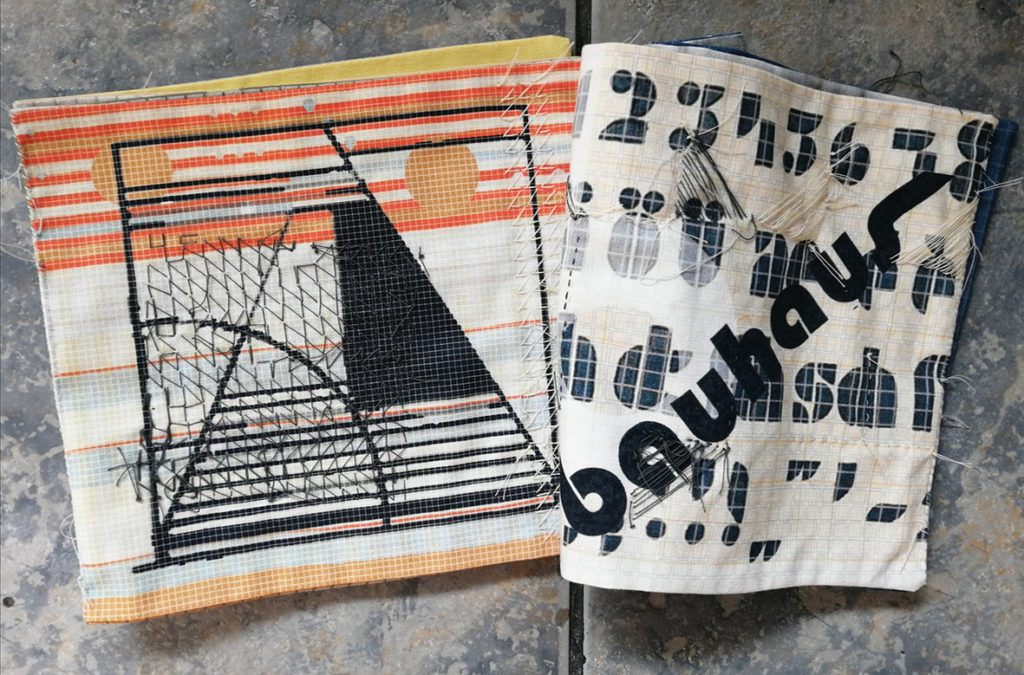
‘Bauhous Pages’, From Travelling Books, 40 x 20 cm,2020
We have committed to carry on, sending images of what we make and with the anticipation that one day we will be able to share all our individual efforts in person. This is our 21st year anniversary as a guild and we are preparing for a group exhibition later in the year.

21st Anniversary Exhibition for ‘Aspects of Stitch’ 20 x 20 cm, 2020
Do historical periods immediately bring certain colours to you mind and why?
Not as such. Colour is often thematic. For instance ‘Lazarus’ was about the English War of the Roses so a reduced palette of black alongside the red and white roses representing the Houses of Lancaster and York.
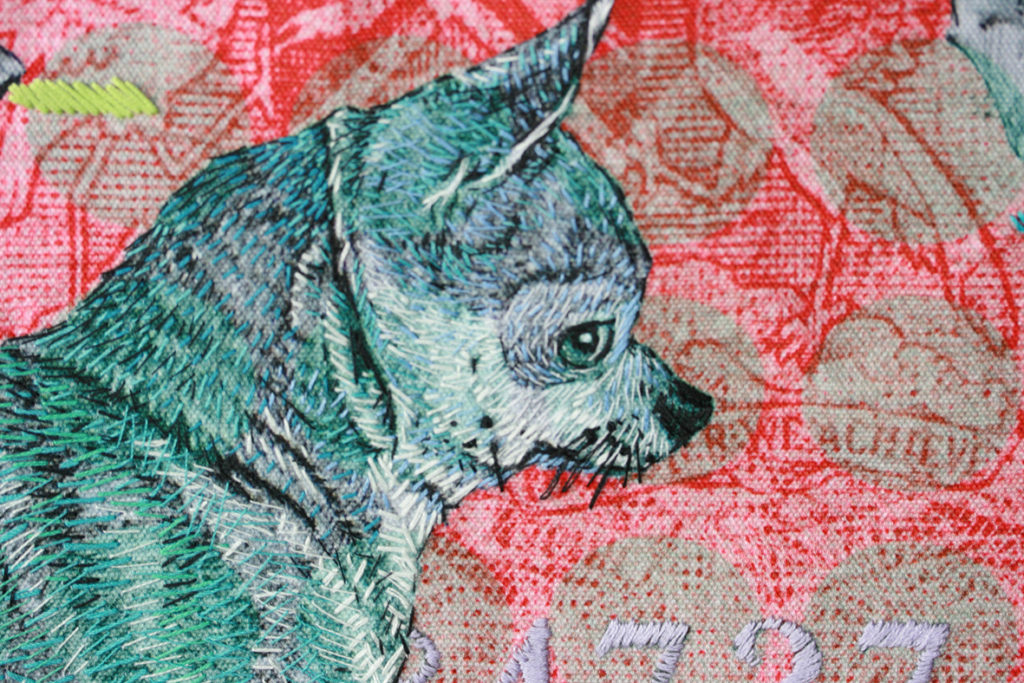
Detail,’Trinidad and Tobago’, from Gone to the Dogs’, 140 x 140cm, 2011
When I showed the collection I realised it had been heavily influenced by the death of David Bowie that occurred during its creation, hence the title and the last few outfits featured the blue birds of hope from that song.
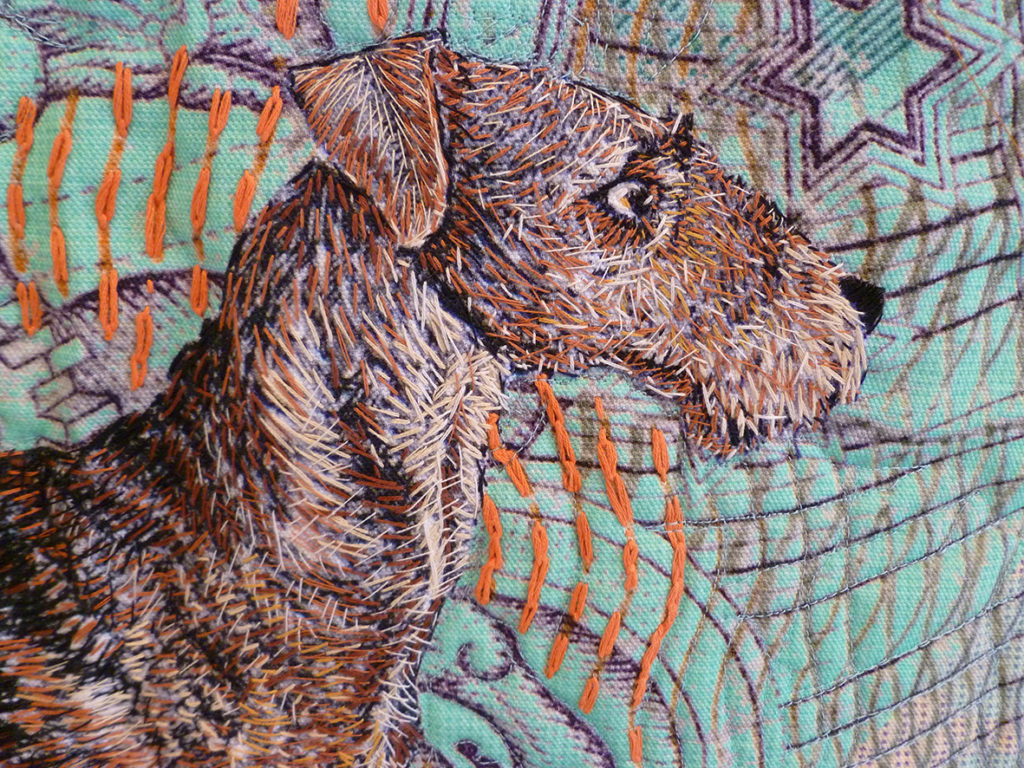
Detail, ‘Cinquecento’ from ‘Gone to the Dogs’, 140 x 140 cm, 2011
The coat for the Lethbridge Sisters uses the colour palette from their Tree of life embroideries so would have a period quality.
You use the natural world in your work, how have you introduced this into your textiles?
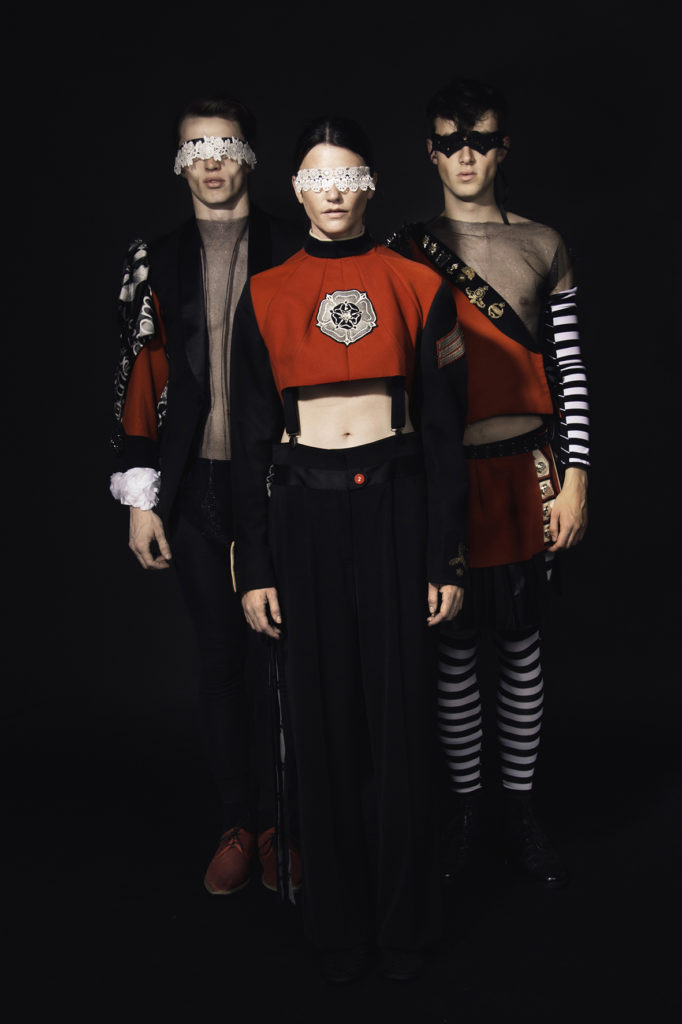
The red and black approach to the war of the roses from ‘Adaptions’, 2016
I like the challenge of representing the forms of creatures and the textures of their fur or plumage but I don’t want to apply actual feathers. I did try some small samples with porcupine quills as they have such beautiful mottling but it was a dead end. In my more figurative work the creatures do become characters in the implied narratives.
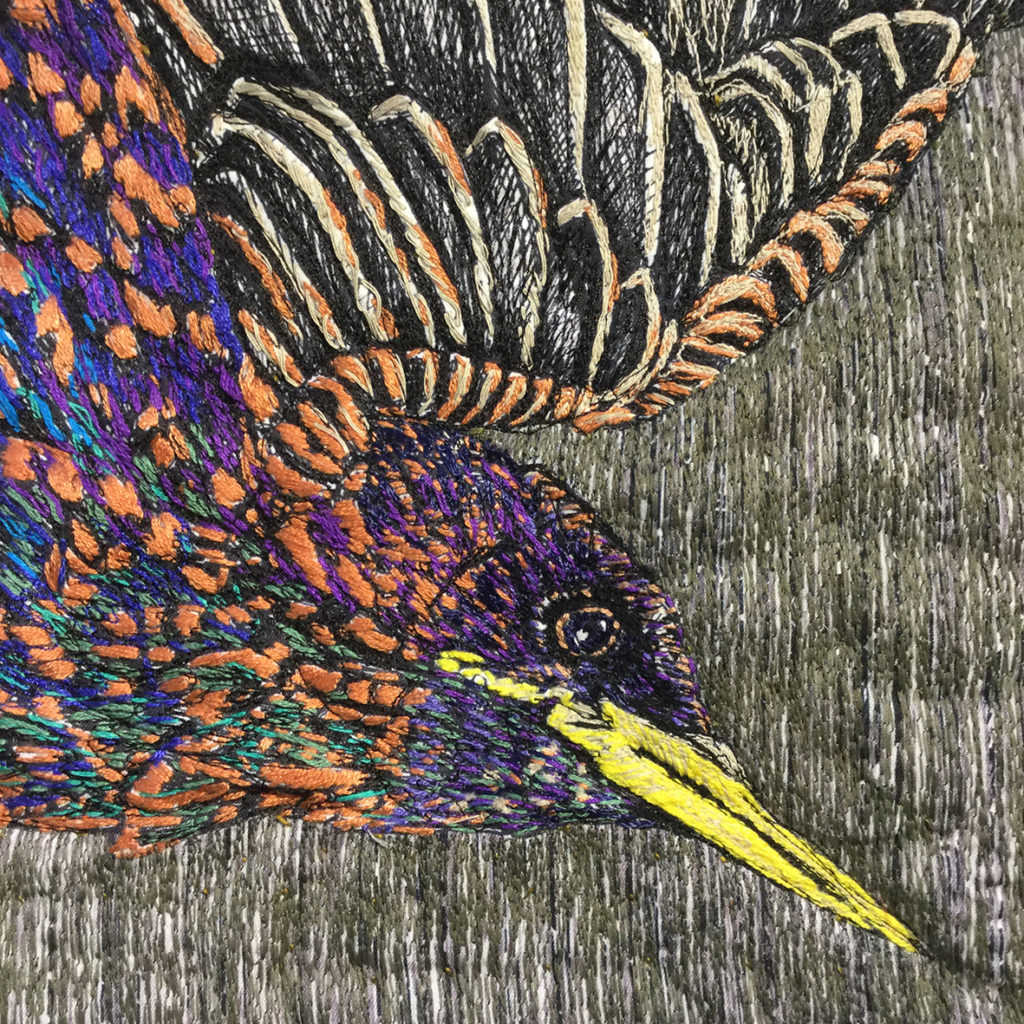
‘Sorrow’ Starlings Detail, 50 x 150cm, hand stitched on wool, 2017
I know there are people who have particular aversions to specific things. Someone I know will not even look at work with images in birds in it, another is frightened of dogs. My interests vary from the deeply symbolic to the often intuitive or random. The oak leaves are a good example of something from nature that satisfies all these criteria.
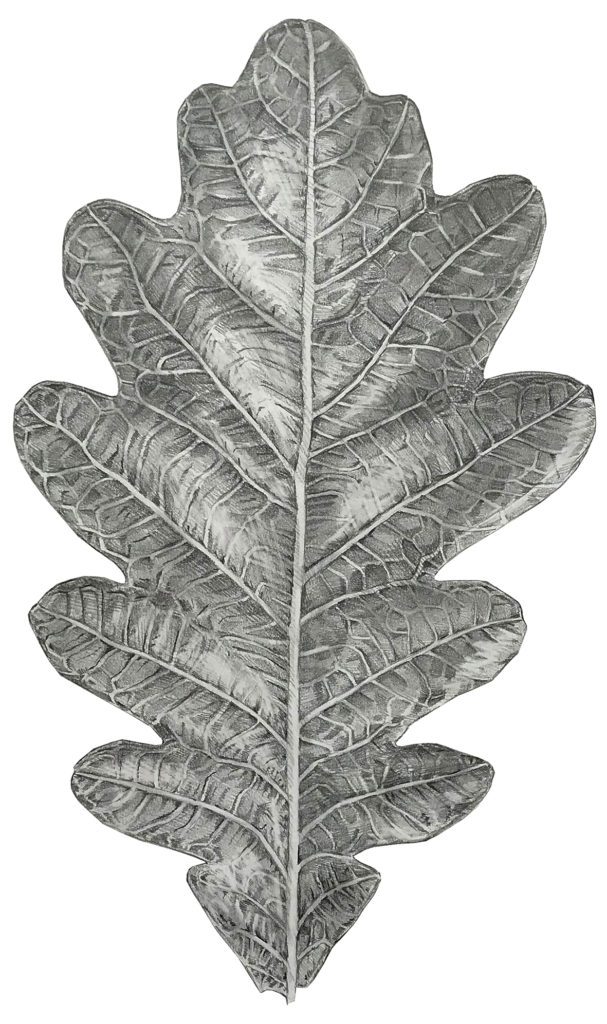 “Oak Leaf’ drawing, Graphite on paper., 20 x 20cm
“Oak Leaf’ drawing, Graphite on paper., 20 x 20cm
The hare, discuss how he came into your work and is he always present in you work?
Not always, and sometimes the hare is definitely female.

‘Lady Hare’ Buttons on digital print, 20 x 30cm, 2020
I don’t identify with the hare as necessarily an avatar. It’s certainly not like Tilleke Schwarz and her carrot motif that features as a visual signature in every work.
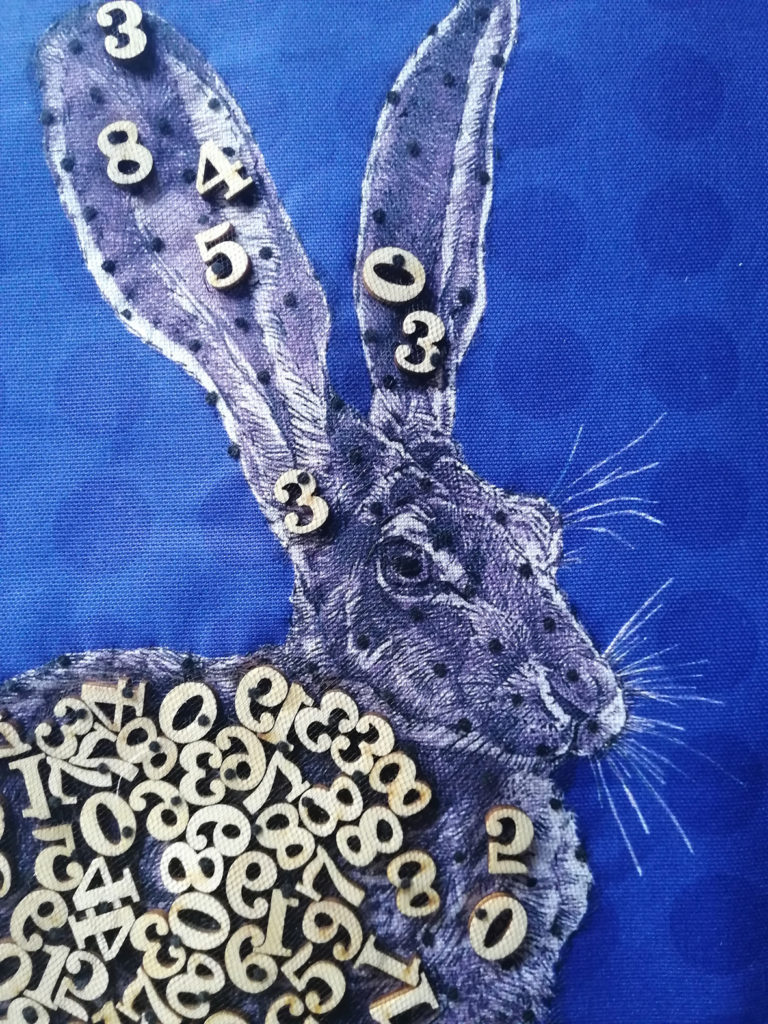
Detail, ‘Numbers Hare’ laser cut mdf, trapped under polyester net and over digital print on cotton, 20 x 30cm, 2020
I remember being mesmerised by Kit Williams’ ‘Masquerade’ book from my childhood with his treasure hare hidden in every image. I remember we had pet rabbits that were my sisters and just seemed to be a lot of smell and trouble. Especially chasing to recapture when they escaped from their pen.
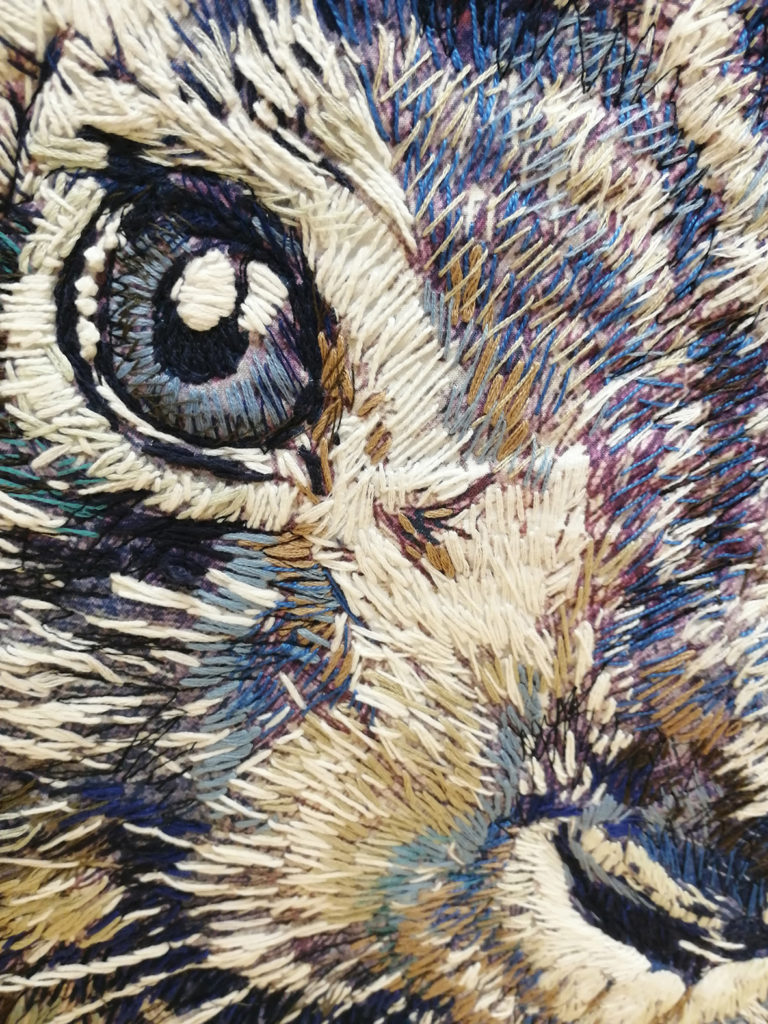
Detail, Hare’s Eye’ from Guardians 7’ Hand stitched over digital print, 50 x 150cm, 2018
I remember an illustrated ‘tortoise and the hare’ book and it was only until my 40’s I finally accepted that I am the Hare and not the Tortoise.

‘Hare and the Moon’ Hand stitch over digital print, 20 x 20cm, 2020
The visit to Mexico in 2004 exposed me to their creation myths and the stylised hares in the Anthropological museum really spoke to me.
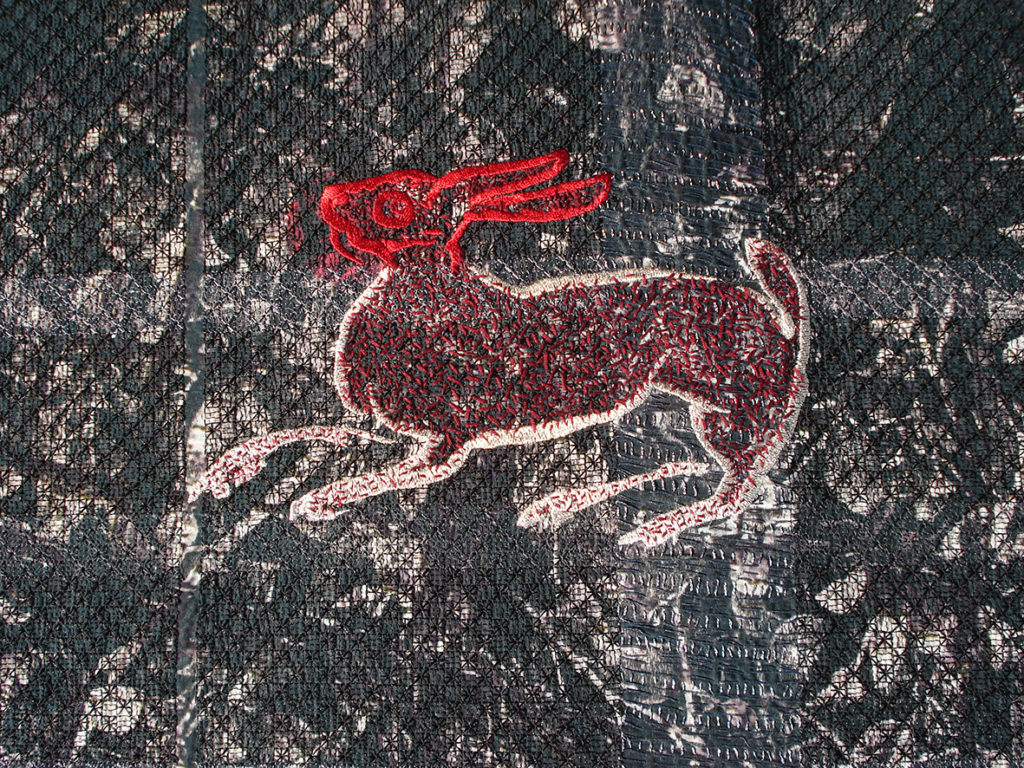
‘Rabbit Moon Schiffli’ embroidered over digital print, 120 x 120cm, 2018
Recently I have expanded on the superb blue fairy wrens

Fairy Wren detail from ‘Delft Blue 8’ detail, Hand stitch, over digital print, 50 x 150cm, 2018
to look at more foxes:
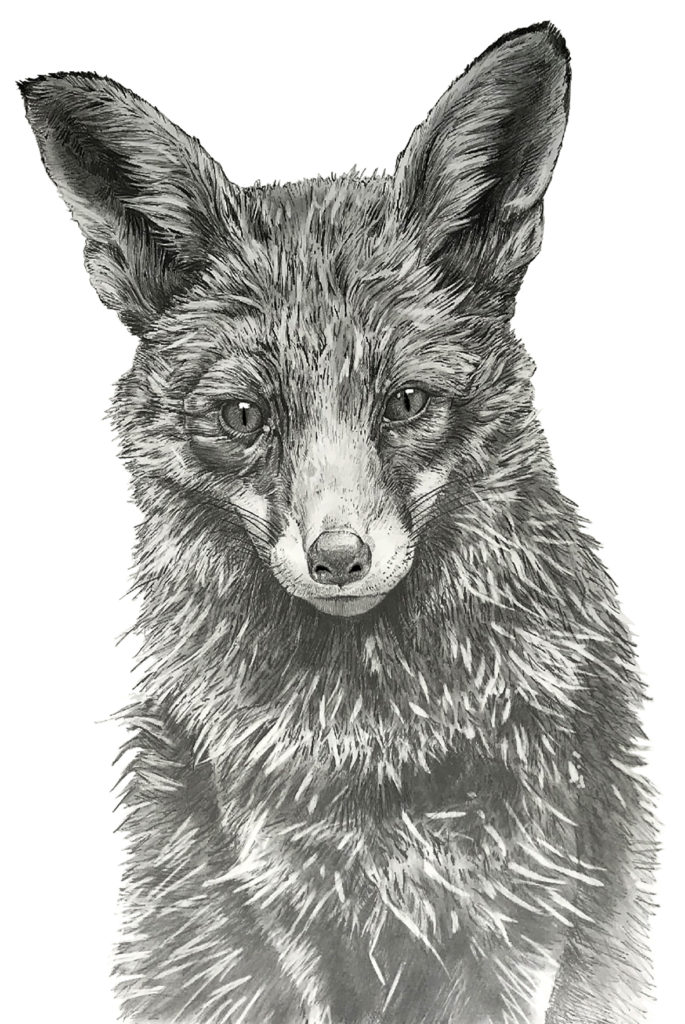
A1 Fox drawing, Graphite on paper 2019
Bears:
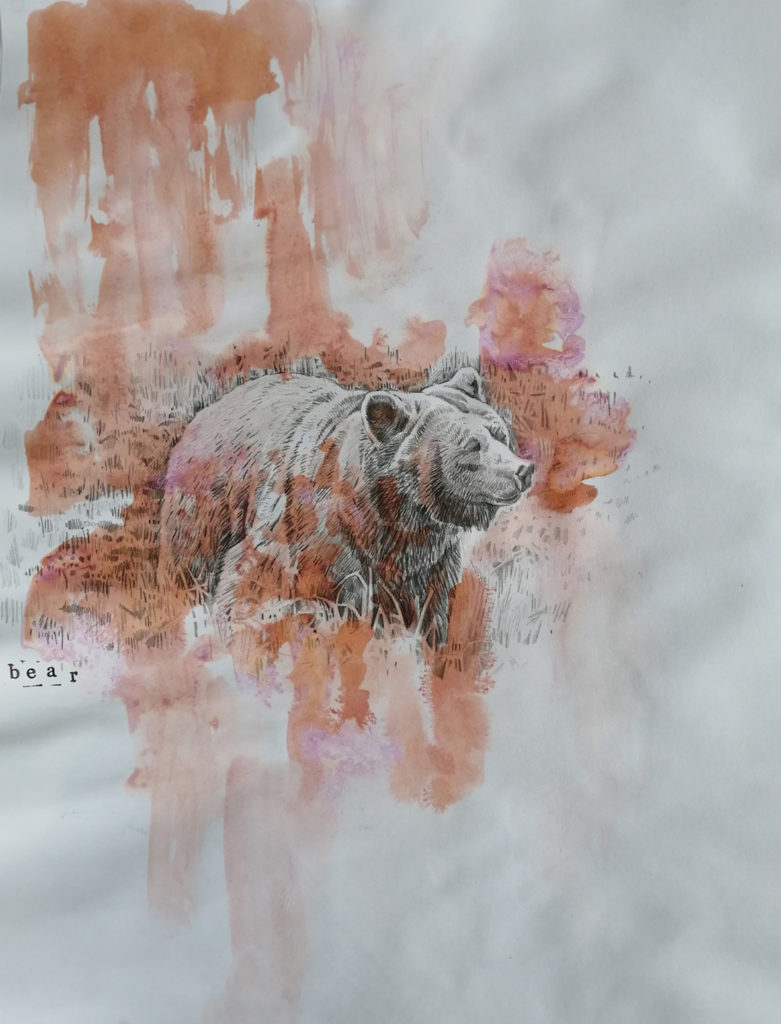
Pencil and Indian Ink, Sketch, Pencil, 2019
These are mostly still at the drawing stage but stitch will happen.
When I moved back to the UK in 2017. I made some mood boards of stuff that I had always liked and would always like. It was somewhere to start. I committed to the colour blue and images of the hare and the moon for a perpetual series that I could always add to.
You comment “I love cloth to have a purpose.” Discuss.
I’m not sure of the original context of that quote but I suppose I mean two things. Textile people tend to be hoarders. The ceiling of our bungalow is sagging through the weight of my much, edited fabric stash in the loft. I have focused certain exhibitions to deliberately use the treasures from many years, but there is always more. There must be a reason to transform that piece of cloth into something else. It must have purpose. I hate waste. I am not a recycling warrior but have always repurposed and reinvented from both sentimental attachment and the haptic material memory that cloth has. I suppose more often from poverty and frugality. Recently we have been looking at old photos and I have a physical sensation to that representation of the materiality of things I was wearing; that wool jumper was itchy, those polyester shorts felt ‘slippy’. I appreciate the quality of certain luxury fibres but need to justify the additional expense when there are far cheaper alternatives, especially from craft suppliers. Its purpose is to be more than a fragment in a box that is unseen or unused.
Secondly, would be with regard to my teaching, specifically that has often been to students who are very focused on making their work wearable or with a specific function. When I have used existing clothing forms like the uniforms.

‘Decorated’ NCCD Sleaford, 2017
I was challenged by many to make them wearable but that when I experimented on things that could accommodate the human form rather than being wall based that I was actually making costume not fashion.
How is Corona Virus effected your art and your academic practice?
My immediate family are well. Knock on wood (picture me tapping my skull). At times the situation is abstract. We are blessed with good neighbours and family who do our shopping. Embroidery has prepared me for self-isolating. We have a lovely garden and I have those I love most here with me. Staying at home has been easy. It has terminated all my employment and income. Things I had been preparing for for months are gone or postponed to some indefinite point in a possible future. I am lucky compared to many who are self-employed. That is as nothing compared to the grief of so many. It has taken the last of one line of our family, two elderly ladies, who were both in previous good health despite their age. None of their children or grandchildren could see them in the last month of their lives. Their funerals had a limit of less than a handful of mourners. We sat by a computer watching via a link. Those experiences will never leave me.
In practical terms I am someone who has always loved deadlines. I need the reassurance of a plan and the knowledge I can refocus as circumstances change. I love a morning swim (obviously not allowed now as the Leisure Centre is closed) as I find my mind rehearses the day’s events and allows me to relax into the day with confidence. It controls my sometimes, overwhelming anxiety. Now I simply plan what I can do between the current meal and the next. It is not healthy. It is one of the things I am struggling with the most, at the moment. Often my diary is full 2 years in advance, and certainly when I was teaching full time I was always forward planning several semesters ahead. Now I have the vague possibility of Three postponed workshops and one booking for November 2021. It is terrifying. Luckily I don’t have to try and negotiate the minefield for this current crop of students and their rite of passage of a degree show. The coronial generation of those studying through this will face challenges we cannot dream of. Universities have moved seamlessly to expectations of a delivery and assessment of a virtual programme. I applaud the efforts of staff to make this happen. Textiles is not a virtual experience. The internet is a tool but not the answer.
 Contact:
Contact:
Nigel Cheney
Email nigelcheney@gmail.com
Website www.nigelcheney.com
Deborah Blakeley, Melbourne, Australia
Interview by Deborah Blakeley, June 2020
Think a colleague or friend could benefit from this interview?
Knowledge is one of the biggest assets in any business. So why not forward this on to your friends and colleagues so they too can start taking advantage of the insightful information the artist has given?
Other artists you may be interested in:




